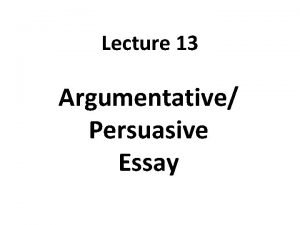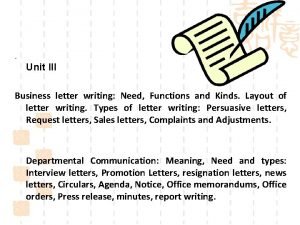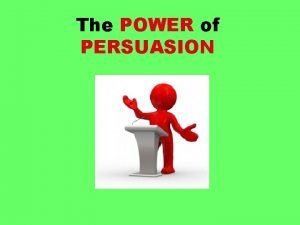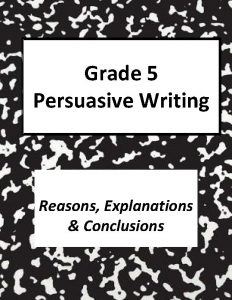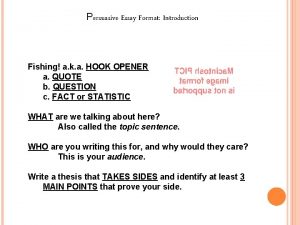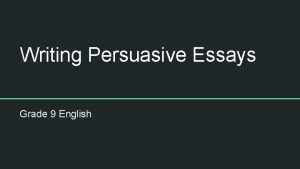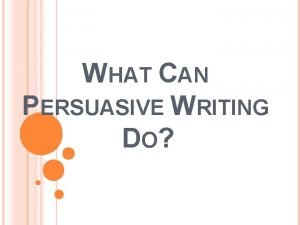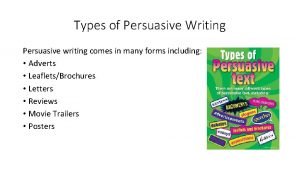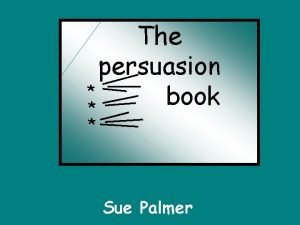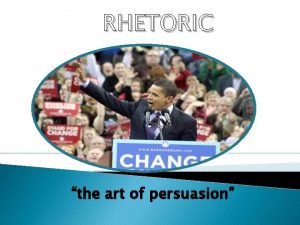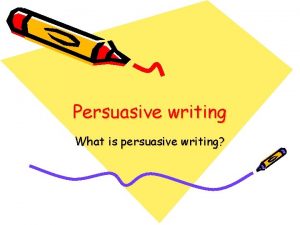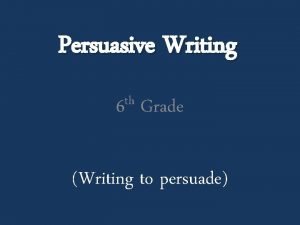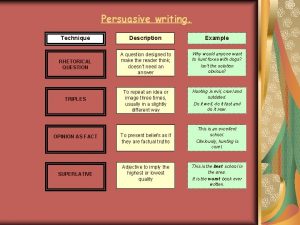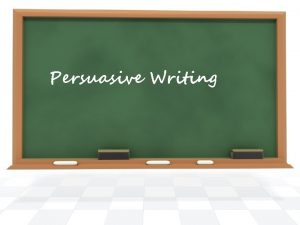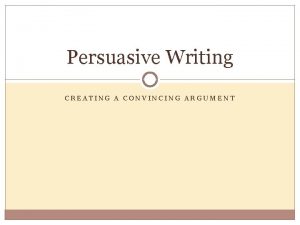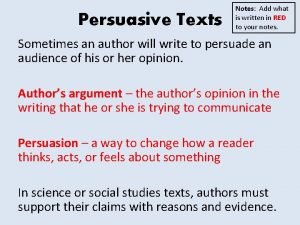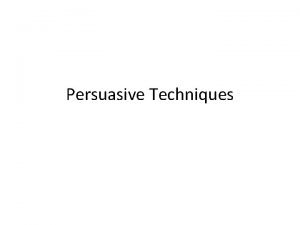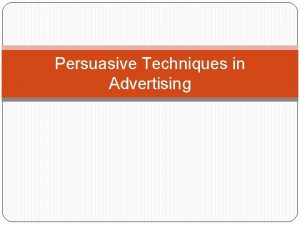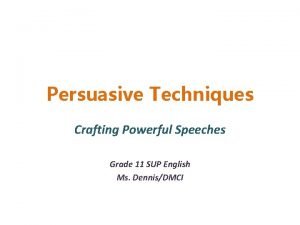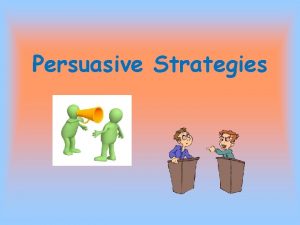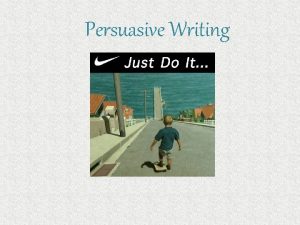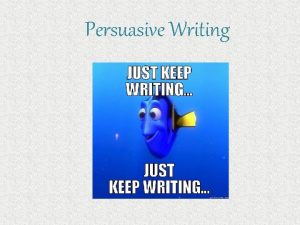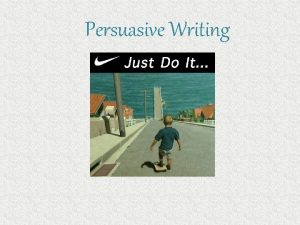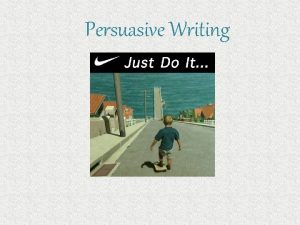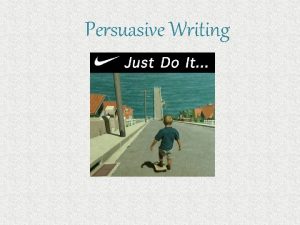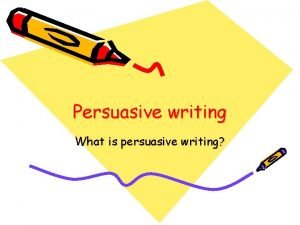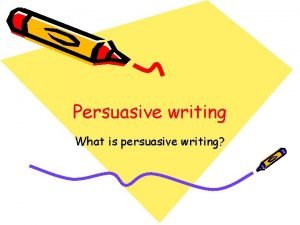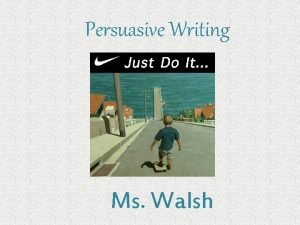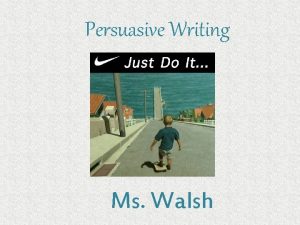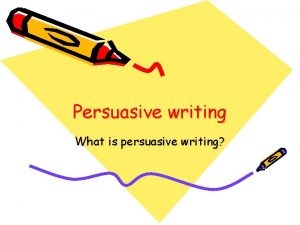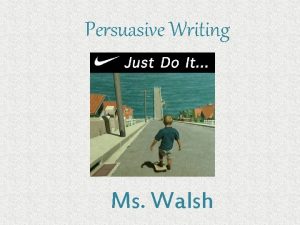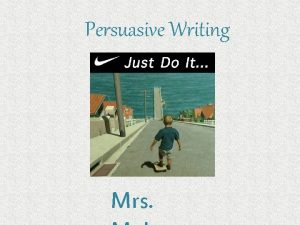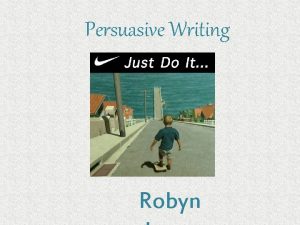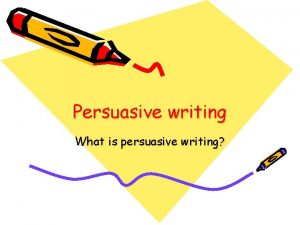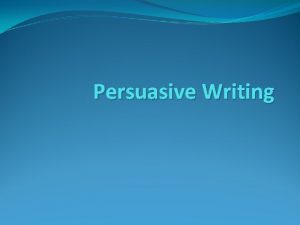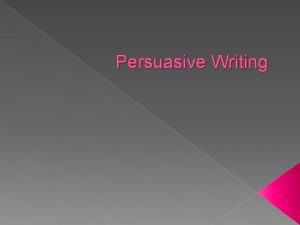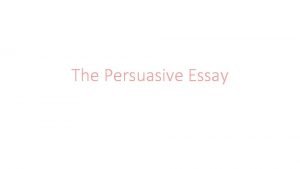Persuasive writing follows a certain format INTRODUCTION with


























- Slides: 26

Persuasive writing follows a certain format: • INTRODUCTION with a “hook” and thesis statement • BODY where the argument is explained • CONCLUSION where main points are summarized and reviewed and the reader is left with something to think about.

First…Know Your Audience… • Before you start writing, you should know your audience: – Who will read your writing? Who do you need to convince? – The audience may be your friends, your teacher, your parents, your principal, the readers of a newspaper or the President of the United States! – Will you be graded? On What? – Should you be casual or professional?

Second… Pick a side! • The writer must clearly state his/her position and stay with that position. Pick a side! • Generally, the position is stated in the opening paragraph or introduction.

Three: Do Your Research… In order to convince the reader you need more than just an opinion; you need facts or examples to back your opinion. So, be sure to do the research!

Four: MAKE A PLAN, then write! The 6 Paragraph Essay: 1. Introduction/Hook/Thesis 2. Argument 1 with support 3. Argument 2 with support 4. Argument 3 with support 5. Conclusion

DOS and DON’Ts of Persuasive Writing: • Do: • Divide into 5 paragraphs • Have a thesis statement in your introduction • Come up with 3 main points to support your argument— these will be your 3 body paragraphs • Show the “counter argument” • Have a conclusion that has a “clincher statement” • Don’t : • Don’t begin with “Hello my name is___ and I’m going to write about____” • Don’t use the word “I “ (Instead of “I think we shouldn’t wear uniforms” say “Uniforms shouldn’t be required. ” • Don’t be wishy-washy. Pick a side! • Don’t forget to support your opinions with facts and example s

The Great Introduction… What makes an good introduction? • It grabs or “hooks” the reader’s attention by using one or more of the following strategies: – An anecdote or scenario – A quotation – An interesting fact or statistic – A question • It tells how the writing will be organized. • The author’s position is clearly stated in a thesis statement.

Grabbing Your Audience… Good strategies used in introductions: • Use an Anecdote/ Scenario – The writer provides a personal experience or made-up situation to introduce the position. • Questioning – The writer asks thought-provoking questions to capture the reader’s interest. • Interesting fact or statistic – The writer gives an interesting piece of information to grab the reader’s attention. Lets Take A Look….

You Could Start with a Riddle: • Get your reader’s attention with a challenging thought. • “What’s plain, and boring? What makes all students in a school building look the same and lose their individuality? If you guessed UNIFORMS, you’re correct!”

You Could Begin with a Strong Statement: • Example: • Fast food consumption has risen 500 percent since 1970 and today reaches nearly every part of society, including some public school cafeterias.

You Could Open with a Quotation: Paraphrased quotation Dr Ong Toon Yeoh of the MMA recently observed that youngsters today have developed unhealthy eating habits that centered on the consumption of high fat fast food and sugary beverages. “If left unchecked, we will have a future generation suffering from chronic lifestyle diseases such as cardiovascular disease and diabetes” he said. Such concerns are valid given that Malaysians consume, on average, up to 3 tonnes of fast food annually. Increased consumption of cholestrol rich food such as fast food is harmful because …………… Actual quotation

You Could Open with a interesting fact: • Example: • “Did you know that a typical child needs 2, 000 calories for an entire day and Burger King’s Whopper with triple cheese has 1, 230 calories? ”

You Could Open with an Anecdote: • An anecdote can provide an amusing and attention-getting opening if it is short and to the point. • “My hands felt sticky after pulling open the doors to “Big Mac’s Burger Hut”. The odor reeked of fried food. I ordered a Big Mac. Combo #2. There was enough food to serve a small third world country on my tray! I nibbled happily at the ¾ pound burger and soon my chin was covered in a mayonnaise and ketchup concoction, all the while oblivious to the reality that fast food is harmful because ……………. . Note how the writer combines the anecdote with the thrust of the topic

You Could Open with a Fact or Statistic: • Example: • Thirty percent of the children in the survey ate fast food on any given day during the survey, and they ate an average of 187 calories a day more than those who did not eat fast food. These additional calories could account for an extra six pounds of weight gain per year, according to Seattle based, Ludwig Health Institute.

You Could Open with a Question: • How many times have you eaten fast food this month?

Next: Creating a Thesis Statement • A thesis statement is one sentence at the end of your introduction that states your opinion. It needs to be strong. • First, choose 3 main focus points to discuss in your essay. These points will become the focus of three paragraphs in the body of your paper. Let’s use fast food as an example again. Fast food…(3 Discussion Points) • rapidly increases weight • causes high blood pressure • contributes to atherosclerosis

Writing the Thesis Statement • Now take your three main focus points and summarize them. Put your completed thesis statement at the end of your first paragraph. A COMPLETED THESIS STATEMENT (Containing THREE MAIN FOCUS POINTS) : I believe fast food is harmful because it rapidly increases weight, causes high blood pressure, and contributes to atherosclerosis. .

Our Introductory Paragraph: HOOK THE READER (USE A RHETORICAL QUESTION) Did you know that a typical child needs 2, 000 calories for an entire day and Burger King’s Whopper with triple cheese has 2, 230 calories? That is far more calories than anyone needs in one day in one burger! Fast food consumption has risen 500 percent since 1970 and today it is ubiquitous in every part of our daily lifes, including being served in some public school cafeterias. Fast food is harmful because it rapidly increases weight, causes high blood pressure, and contributes to artherosclerosis. THESIS STATEMENT YOUR THREE POINTS/ ARGUMENTS

Three Supporting Paragraphs: • Use each of the main arguments you used in your introductory paragraph and expand on each giving facts and reasons. • In our example, you would write one paragraph on how fast food increases weight, one paragraph on how it causes high blood pressure and one on how it contributes to atherosclerosis. • Now lets see how it is done with point no 3. Next, try to develop points 1 and 2 on your own.

Example on how to develop a paragraph : observe the step by step elaboration of the main idea being scaffolded by supporting details and the process culminates in a conclusion that relates back to the main idea (through the word “atherosclerosis”). This is what we term as logical cohesion, a key element of good essay writing. Contributes to atherosclerosis (thesis) Fast food – contains high levels of lipids of the LDL variety. Fast food - high carbon content due to extensive use of the frying technique in food preparation LDL responsible for the formation of Carbon –promotes destruction endothelium plaque in the bloodstream – that layer of blood arteries – allowing fat deposits to eventually attaches to carbon damaged attach to arterial walls artery linings – narrows arteries and blood flow - vital organs – heart, brain, kidneys LDL + carbon = atherosclerosis

The writer provides cohesion through the use of connectives, repetition of key words and ideas. Thesis statement Fast food also contributes towards the pathogenesis of atherosclerosis, a condition that narrows blood arteries and thus reduces blood flow to vital organs. This condition develops when a high concentration of Low Density Lipoproteins (LDL)found in fast food allow for the formation of fat deposits in the bloodstream. Gradually, these fat deposits attach themselves to arterial walls and consequently form plaques that impede blood circulation to vital organs such as the heart, the brain and the kidneys. Besides LDLs, fast food also has a high carbon content due to the frying technique predominantly used in its preparation. These carbon elements promote the destruction of the endothelium layer of blood arteries. Subsequently this destruction accelerates the accumulation of fatty deposits in the arterial wall as plaque It can thus be surmised that the development of atherosclerosis is facilitated by the presence of precursors such as LDLs and carbon in fast food. Can you identify a. connectives, transitions, linkers that provide cohesion? b. the repetition of key words/phrases or ideas that provide linkages? c. the summation for this point?

Conclude Your Essay… What makes an good conclusion? · The last paragraph wraps up the writing and gives the reader something to think about. · End using one or more of the following strategies: – Restatement – Summary of argument – Rhetorical Q – Plan of action – Visualise expectations

Strategies for Conclusions (1) Restate Reiterate your stance by emphasising your thesis (2) Summarise your reasons for your restatement in (1) (3) Rhetorical Question (optional) RQs provide an alternative way for the writer to engage the reader so as to consider the options outlined (4) Visualise Expectation the writer posits what the reader should do given the circumstances. In other words, the writer persuades the reader to adopt a plan of action that is most beneficial in the given context.

Concluding Paragraph: Restate your thesis. In conclusion, it’s important to remember that too much fast food can have negative effects on your health. If not eaten in moderation, you will gain weight, suffer from high blood pressure and be afflicted with atherosclerosis. Is it worth the risk to your body? So adopt healthy eating habits today by consuming wholesome nutritious food! Ending with… – A restatement (fast food – negative effects) – Consequences ( summary of 3 points again!) – A question (Are you willing to risk your health? ) – A call to action (I highly recommend you consider your options the next time your faced with a decision about what to eat. )

Review: The Essay: • Introductory paragraph with a “hook”, a thesis that establishes your stance and three main points to support it. • A paragraph for each of your three arguments. • Remember you can either have one sub-point with examples to develop your main idea or use two subpoints in tandem as I showed you in my third point above. • Closing paragraph that re-states your thesis and challenges the reader to think about it.

Don’t Forget… • Make sure to read over your work and edit for mechanics and spelling. • Write neatly! • Use the appropriate vocabulary. • Follow the proper format: 5 paragraphs : intro + 3 points + conclusion
 Argumentative writing and persuasive writing
Argumentative writing and persuasive writing Argumentative essay vs expository essay
Argumentative essay vs expository essay Order of an introduction paragraph
Order of an introduction paragraph Miscellaneous parts of a business letter
Miscellaneous parts of a business letter Persuasive format
Persuasive format Grade 5 persuasive writing
Grade 5 persuasive writing Persuasive essay layout
Persuasive essay layout Persuasive pronouns
Persuasive pronouns Grade 9 essay topics
Grade 9 essay topics I wanna iguana persuasive writing
I wanna iguana persuasive writing Types of persuasive writing
Types of persuasive writing Sue palmer skeletons
Sue palmer skeletons Rhetoric: the art of persuasive writing and public speaking
Rhetoric: the art of persuasive writing and public speaking Persuasive wrting
Persuasive wrting Persuasive writing 6th grade
Persuasive writing 6th grade Rhetorical questions in persuasive writing
Rhetorical questions in persuasive writing A persuasive writer attempts to
A persuasive writer attempts to Importance of planting trees essay
Importance of planting trees essay Persuasive text structure year 7
Persuasive text structure year 7 Persuaive words
Persuaive words Persuasive writing in advertising
Persuasive writing in advertising Persuasive writing notes
Persuasive writing notes Repetition persuasive technique examples
Repetition persuasive technique examples Advertising techniques bandwagon
Advertising techniques bandwagon Speech persuasive techniques
Speech persuasive techniques Claim persuasive
Claim persuasive Form of persuasive writing
Form of persuasive writing
